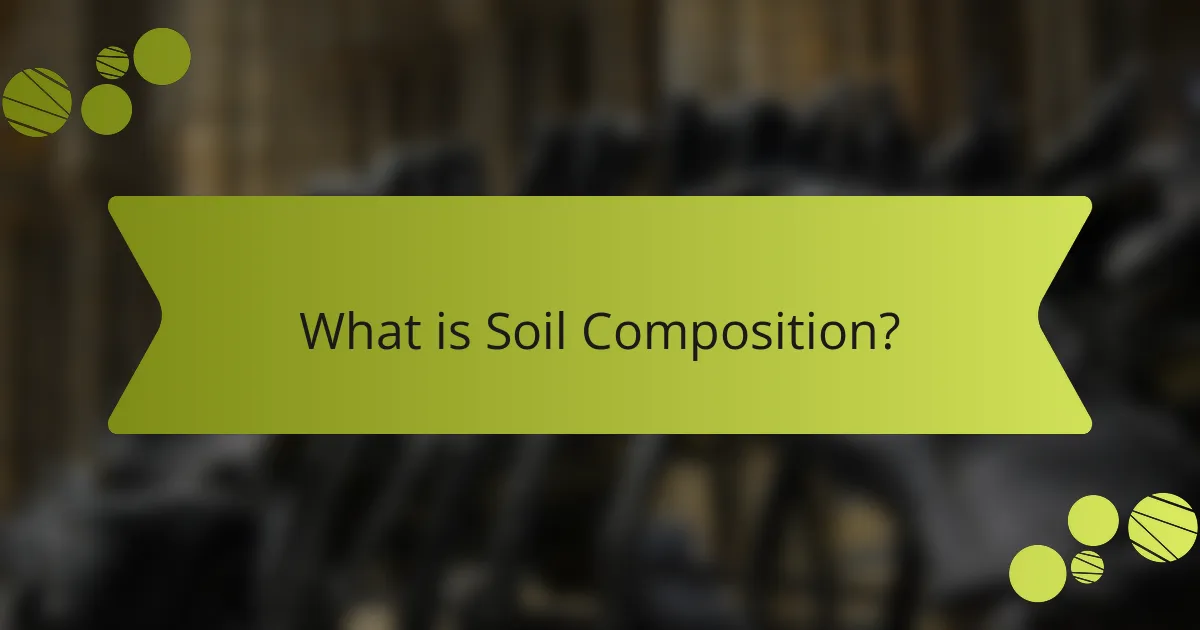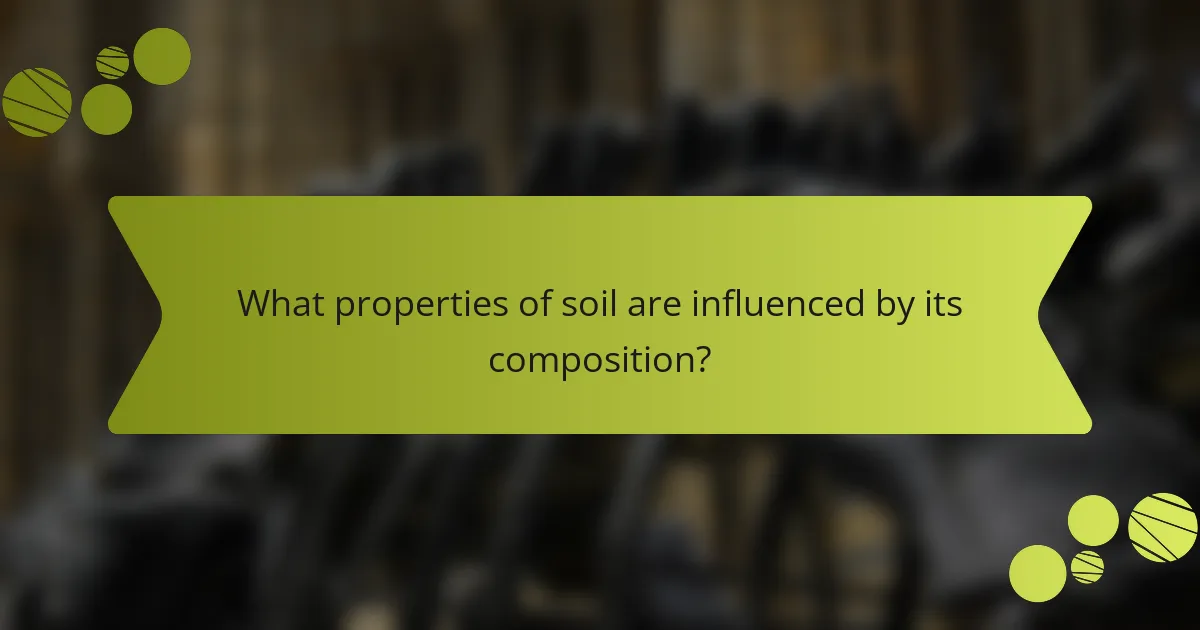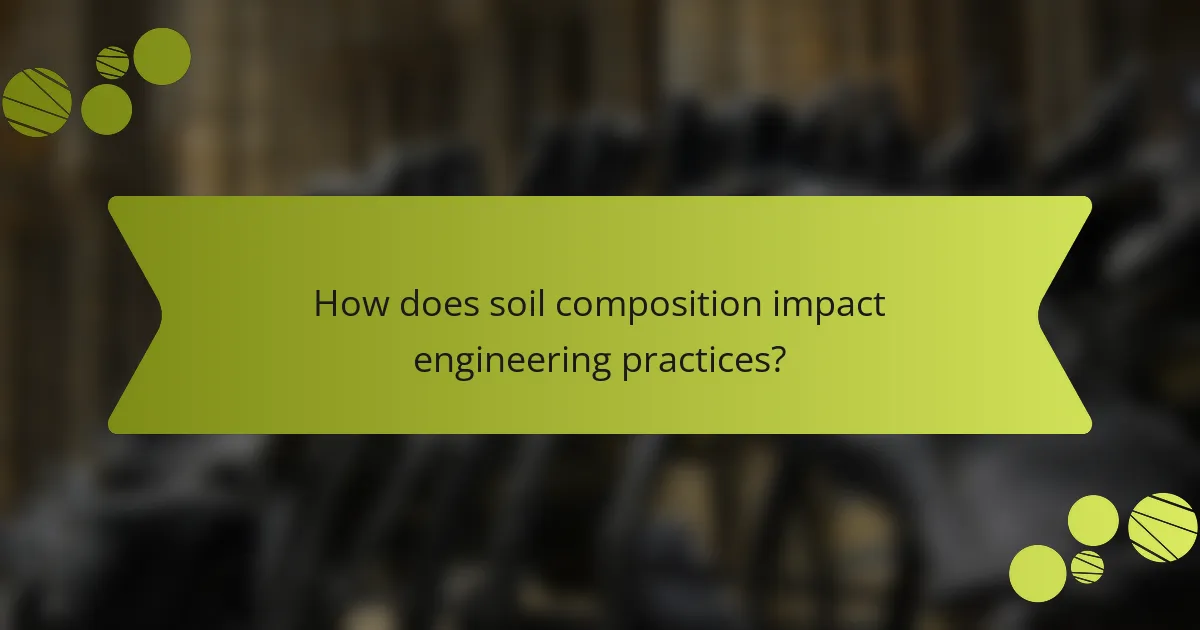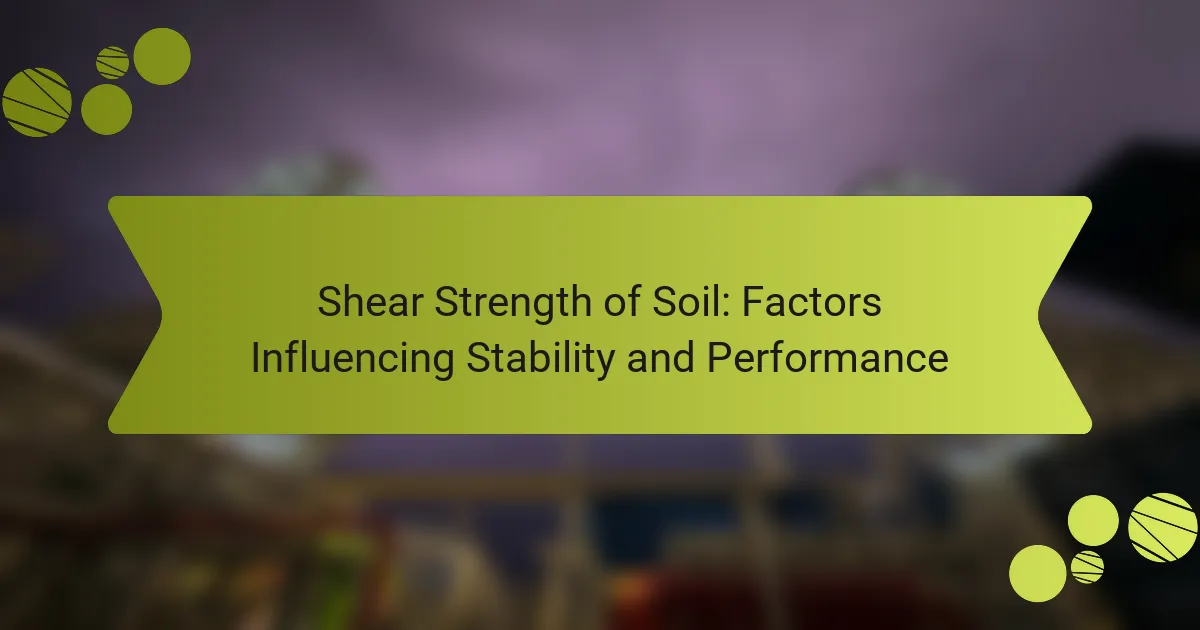Soil composition is the specific mixture of organic matter, minerals, gases, liquids, and organisms that make up soil. The primary components include mineral particles (sand, silt, and clay), organic matter, water, and air, all of which influence soil properties like texture, structure, porosity, and nutrient availability. These properties are crucial for effective land use and engineering applications, as different soil types can impact construction methods and structural stability. Understanding soil composition allows engineers to conduct necessary soil tests, assess attributes such as grain size and moisture content, and design appropriate foundations, thereby preventing costly failures and ensuring safety in engineering projects.

What is Soil Composition?
Soil composition refers to the specific mixture of organic matter, minerals, gases, liquids, and organisms in soil. The primary components include mineral particles, organic matter, water, and air. Mineral particles consist of sand, silt, and clay, which influence soil texture and drainage. Organic matter enriches soil fertility and supports microbial life. Soil water is crucial for plant growth, while air in soil pores allows for gas exchange. The relative proportions of these components determine soil properties, such as nutrient availability and stability. Understanding soil composition is essential for effective land use and engineering applications.
What are the key components of soil composition?
The key components of soil composition are minerals, organic matter, water, and air. Minerals make up the largest portion of soil and provide essential nutrients. They originate from the weathering of rocks and can include sand, silt, and clay. Organic matter consists of decomposed plant and animal materials, enriching soil fertility. Water is crucial for plant growth and soil chemical reactions. Air in the soil is necessary for respiration of roots and microorganisms. Together, these components determine soil structure and its ability to support vegetation.
How do mineral particles contribute to soil composition?
Mineral particles are essential components of soil composition. They provide the primary structure and stability to the soil. Mineral particles include sand, silt, and clay. Each type of mineral particle contributes differently to soil texture. Sand particles are large and improve drainage. Silt particles are medium-sized and enhance nutrient retention. Clay particles are small and offer high water-holding capacity. Together, these particles determine the soil’s physical properties. Soil composition affects water infiltration, aeration, and root [censured]. The balance of these mineral particles influences soil fertility and crop production.
What role do organic matter and humus play in soil composition?
Organic matter and humus are essential components of soil composition. They enhance soil fertility and structure. Organic matter improves nutrient retention and water-holding capacity. It also fosters beneficial microbial activity. Humus, a stable form of organic matter, contributes to soil aeration and drainage. Additionally, humus helps in the formation of soil aggregates. These aggregates improve soil stability and reduce erosion. Studies show that soils rich in organic matter have higher productivity. Thus, organic matter and humus play a crucial role in maintaining healthy soil ecosystems.
Why is understanding soil composition important in engineering?
Understanding soil composition is crucial in engineering because it affects structural stability and design. Soil composition influences load-bearing capacity, drainage, and erosion potential. Engineers use this information to assess risks and determine suitable construction methods. For example, clay-rich soils can expand or contract, impacting foundations. Conversely, sandy soils may drain quickly but provide less support. Accurate soil analysis helps prevent costly failures and ensures safety. Studies show that poor soil assessment leads to 30% of construction failures. Therefore, understanding soil composition is essential for effective engineering practices.
How does soil composition affect construction projects?
Soil composition significantly affects construction projects. It determines the soil’s load-bearing capacity. Different soil types, such as clay, sand, and silt, exhibit varying strengths. For instance, clay can expand and contract, leading to foundation instability. Sand provides good drainage but may lack cohesion. The presence of organic matter can weaken soil structure. Soil composition influences excavation methods and material selection. Engineers assess soil through geotechnical investigations to ensure project safety. Proper analysis prevents costly construction failures.
What are the implications of soil composition on foundation stability?
Soil composition significantly impacts foundation stability. Different soil types exhibit varying load-bearing capacities. Cohesive soils, like clay, can expand and contract with moisture changes. This property can lead to foundation movement or settling. Granular soils, such as sand, provide better drainage and stability. However, they can also shift under load if not properly compacted. Soil composition determines the foundation design required for adequate support. For instance, heavy structures may need deeper foundations in less stable soils. Research indicates that improper consideration of soil composition can lead to structural failures. The American Society of Civil Engineers emphasizes soil testing for foundation planning.

What properties of soil are influenced by its composition?
Soil composition influences several properties, including texture, structure, porosity, and nutrient availability. Texture refers to the proportions of sand, silt, and clay. This affects water retention and aeration. Structure describes the arrangement of soil particles into aggregates. A well-structured soil improves drainage and root [censured]. Porosity indicates the volume of voids within the soil. Higher porosity allows for better water and air movement. Nutrient availability is determined by the mineral content and organic matter in the soil. Soils rich in organic matter typically have higher fertility. These properties directly impact soil behavior and suitability for engineering applications.
How do texture and structure relate to soil composition?
Soil texture and structure significantly influence soil composition. Soil texture refers to the relative proportions of sand, silt, and clay particles. This composition affects water retention, nutrient availability, and aeration. For example, sandy soils drain quickly but retain fewer nutrients. In contrast, clay soils hold water and nutrients but may drain poorly.
Soil structure describes how soil particles aggregate into larger clumps or peds. This arrangement affects porosity and permeability, influencing how air and water move through the soil. Well-structured soil allows for better root growth and microbial activity. Poor structure can lead to compaction, reducing these benefits.
Research shows that both texture and structure are critical for determining soil’s physical and chemical properties. For instance, a study by Hillel (2004) highlights that soil texture and structure directly impact agricultural productivity. Therefore, understanding these relationships is vital for effective soil management and engineering applications.
What are the different soil textures and how do they affect engineering?
Soil textures refer to the composition of soil particles based on size. The main textures include sand, silt, clay, and loam. Sand has large particles, providing good drainage and aeration. Silt consists of medium-sized particles, retaining moisture effectively. Clay has the smallest particles, leading to poor drainage but high plasticity. Loam is a balanced mix of sand, silt, and clay, ideal for plant growth.
These textures affect engineering significantly. Sandy soils provide stability for foundations but may require additional support for structures. Silty soils can retain water, which may lead to erosion or instability in construction. Clay soils expand and contract with moisture changes, impacting structures over time. Loamy soils offer a stable base for construction due to their balanced properties.
Understanding soil texture is crucial for engineers. It influences decisions on foundation design, drainage systems, and construction materials. Proper soil assessment ensures the longevity and safety of engineering projects.
How does soil structure impact water retention and drainage?
Soil structure significantly influences water retention and drainage. Well-structured soils, with aggregated particles, create pore spaces that enhance water holding capacity. These aggregates allow for better infiltration and movement of water. Conversely, poorly structured soils tend to compact, reducing pore spaces. This compaction leads to decreased water retention and increased runoff. Clay soils, for instance, retain water due to their fine particles but may drain poorly. Sandy soils drain quickly but hold less water. Research shows that soil structure affects both the physical and chemical properties of soil, impacting overall water management in agricultural practices.
What physical and chemical properties are determined by soil composition?
Soil composition determines various physical and chemical properties. Physical properties include texture, structure, density, and porosity. Texture refers to the proportion of sand, silt, and clay particles. Structure describes the arrangement of soil particles into aggregates. Density indicates the mass of soil per unit volume, affecting compaction. Porosity measures the void spaces in soil, influencing water retention.
Chemical properties include pH, nutrient content, and cation exchange capacity. pH affects nutrient availability and microbial activity. Nutrient content refers to the presence of essential elements like nitrogen, phosphorus, and potassium. Cation exchange capacity measures the soil’s ability to hold and exchange positively charged ions.
Research indicates that soil composition significantly impacts engineering properties, such as shear strength and compressibility. For example, cohesive soils with high clay content exhibit different engineering behaviors compared to sandy soils. This variation affects construction practices and foundation design.
How does soil pH influence engineering decisions?
Soil pH significantly influences engineering decisions by affecting soil behavior and material compatibility. Engineers assess soil pH to determine its acidity or alkalinity. This measurement influences the choice of construction materials. For example, acidic soils can corrode concrete and steel. Alkaline soils may affect the stability of certain foundations. Soil pH also impacts the availability of nutrients in the ground. This, in turn, affects vegetation growth, which is crucial for slope stability. Additionally, soil pH can influence drainage characteristics. Poor drainage may lead to increased water pressure on structures. Therefore, understanding soil pH is essential for effective engineering design and risk management.
What is the significance of soil permeability in engineering applications?
Soil permeability is significant in engineering applications because it affects water movement through soil. High permeability allows rapid drainage, which is crucial for foundation stability. Conversely, low permeability can lead to waterlogging and increased pressure on structures. Engineers assess soil permeability to design effective drainage systems. It also impacts the selection of construction materials and methods. For instance, permeable soils may require special treatments to enhance stability. Testing methods, like the constant head and falling head tests, provide accurate permeability values. Understanding soil permeability ensures safe and sustainable engineering practices.

How does soil composition impact engineering practices?
Soil composition significantly impacts engineering practices. Different soil types have varying properties that influence construction methods. For instance, clay-rich soils expand when wet and shrink when dry. This behavior can lead to structural instability in buildings. Sandy soils, on the other hand, provide good drainage but may lack cohesion. This can affect the stability of foundations.
The presence of organic matter can enhance soil fertility but also complicates construction. Engineers often conduct soil tests to determine composition before starting projects. These tests reveal attributes like grain size, moisture content, and compaction. Understanding these factors helps in designing appropriate foundations and structures.
For example, the American Society of Civil Engineers emphasizes the importance of soil analysis in their guidelines. Proper assessment can prevent costly failures and ensure safety in engineering projects.
What are the challenges posed by different soil compositions in engineering?
Different soil compositions present various challenges in engineering. Soil type affects load-bearing capacity. Clay soils can expand and contract, leading to structural instability. Sandy soils may have low cohesion, risking erosion and shifting. Silt can retain water, increasing the risk of flooding. Each composition impacts drainage, compaction, and foundation design. Engineers must assess soil properties before construction. Ignoring these factors can result in costly repairs and safety hazards.
How can engineers mitigate risks associated with poor soil composition?
Engineers can mitigate risks associated with poor soil composition by implementing various strategies. They often conduct thorough soil testing to assess composition and stability. This testing includes evaluating soil type, moisture content, and bearing capacity. Based on the results, engineers can choose appropriate foundation designs. Techniques such as soil stabilization improve soil strength and reduce settlement risks. Additionally, using geosynthetics can enhance drainage and support. Engineers may also consider alternative materials or construction methods to accommodate poor soil conditions. These strategies help ensure structural integrity and safety in construction projects.
What testing methods are used to analyze soil composition for engineering projects?
Common testing methods used to analyze soil composition for engineering projects include the Atterberg limits test, grain size analysis, and compaction tests. The Atterberg limits test determines the plasticity characteristics of soil. This test identifies the moisture content at which soil changes from a liquid to a plastic state and from a plastic to a solid state. Grain size analysis measures the distribution of different particle sizes in soil. Techniques such as sieve analysis and hydrometer analysis are commonly employed for this purpose. Compaction tests assess the maximum density of soil when subjected to compactive effort. Standard Proctor and modified Proctor tests are typically used for this analysis. These testing methods provide essential data for understanding soil behavior and suitability for construction projects.
What best practices should engineers follow regarding soil composition?
Engineers should conduct thorough soil analysis before any construction project. This includes testing for soil type, moisture content, and compaction levels. Understanding soil composition helps predict behavior under load. Engineers should also assess the presence of contaminants and organic matter. Proper drainage must be considered to avoid erosion and instability. Soil stabilization techniques can enhance strength and reduce settlement. Regular monitoring during construction is essential for adapting to any changes. These practices are supported by guidelines from organizations such as the American Society of Civil Engineers.
How can engineers ensure optimal soil conditions for construction?
Engineers can ensure optimal soil conditions for construction by conducting thorough soil testing. This involves analyzing soil composition, moisture content, and load-bearing capacity. Engineers utilize methods such as Standard [censured] Tests (SPT) and Cone [censured] Tests (CPT) to gather data. Soil compaction is also crucial; it increases density and stability. Techniques like mechanical compaction and moisture control help achieve desired compaction levels. Additionally, engineers may implement drainage solutions to manage water levels. Proper drainage prevents soil erosion and maintains structural integrity. These practices collectively contribute to a stable foundation for construction projects.
What resources are available for understanding soil composition in engineering?
Key resources for understanding soil composition in engineering include textbooks, research papers, and online databases. Textbooks such as “Principles of Geotechnical Engineering” by Braja M. Das provide foundational knowledge. Research papers from journals like the “Journal of Geotechnical and Geoenvironmental Engineering” offer recent findings. Online databases like the GeoRef database provide access to a wide range of geological literature. Additionally, professional organizations such as the American Society of Civil Engineers (ASCE) publish guidelines and technical reports. These resources collectively enhance the understanding of soil properties and their implications in engineering projects.
Soil composition refers to the specific mixture of organic matter, minerals, gases, liquids, and organisms that make up soil. This article outlines the key components of soil, including mineral particles, organic matter, water, and air, and their influence on soil properties such as texture, structure, and nutrient availability. It also discusses the critical role of soil composition in engineering applications, emphasizing its impact on foundation stability, drainage, and overall construction practices. Understanding these elements is essential for effective land use and engineering design, as different soil types present unique challenges and require tailored solutions.
